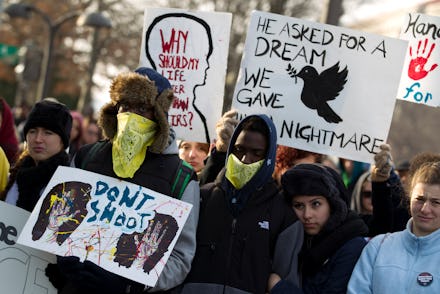We Can Transform Perceptions of Black Men and Boys

The "Pass the Mic" series showcases voices, perspectives and ideas that spark interesting conversations.
As I watched the tragedies unfold in Baltimore and Ferguson and Charleston and cities all across the country, it was clear to me that, in addition to social supports and policies that give black men and boys the chance to learn and thrive, we need better ways to communicate diverse perspectives — that prompt empathy among wider, more diverse audiences. One need only look at the recent New York Times/CBS poll on the growing divide in race relations post-Ferguson and the murder of Michael Brown to see that creating policies that would transform the lives of boys and men of color will require a communications strategy that speaks directly to the emotional anxiety that racial issues trigger on both sides of the conversation.
Negative perceptions of black men and boys are held unconsciously by teachers, health care professionals, police officers, lawmakers, members of the media — really, by all of us. This fuels discriminatory practices in nearly every sphere of our society. Implicit biases and racial anxiety affect our sense of empathy for boys and men of color and our sense of outrage for the conditions they face — and, therefore, our capacity and will to transform the political and policy environment needed to change structural impediments to their success.
The problems of structural racism are far broader than just police violence. Stereotypes of black male criminality are pervasive, and have serious consequences. Black students as young as 4 have been suspended for disrespect. Young black boys are taught how to withhold and withdraw to avoid provoking fear or ire of those around them. Studies show that resumes with black-sounding names are 50% less likely to be called back for interviews, that black people are charged more for cars, that black drivers are twice as likely to be pulled over for the same behavior as white drivers and that black students are suspended for ambiguous reasons like "disrespect" and "loitering" at far higher rates than white students.
The perception of black men and boys is itself a structural barrier. And it can be a matter of life and death.
We cannot accept these obstacles as permanent or insurmountable. Our predecessors in the civil rights movement created a path toward political change that toppled Jim Crow and opened doors previously nailed shut. Civil rights leaders masterfully harnessed the media and popular culture to challenge stereotypes and shed light on the horrors of racial oppression. Their strategies were rooted in a sophisticated understanding of human motivations and the complexity of people's fears and ideals.
Perceptions are complicated, and based on a variety of learned behaviors and stereotypes. Understanding these perceptions and what influences them is crucial to our ability to connect our activism to the messaging and relationship-building that will foster increased understanding, and ultimately the will to change behaviors at the individual and institutional levels. Advances in psychology and neuroscience also allow us to understand the complexities of people's racial reactions, and measure the effect of our toxic racial culture on perceptions and behavior.
With this information we can implement interventions that alter the effect of racial bias and anxiety on the everyday life of black men and boys. For example, according to Perception Institute's research adviser Phillip Atiba Goff's Center for Policing Equity, we can make policing fairer by using data to identify officers likely to engage in biased practices. In education, simply removing identifying demographic information from high stakes tests can improve scores for black students. Using data to track suspension rates by race can help us see where bias may be affecting decision making, while following specific scripts when providing criticism to students of color can help increase their desire to learn and improve.
At the root of this work is the need to present a different kind of conversation that is inclusive, productive and creative, so we can address our perceptions of black men and boys and work together to shift them.
This essay is part of the "Shifting Perceptions: Being Black in America" series commissioned by the Perception Institute.